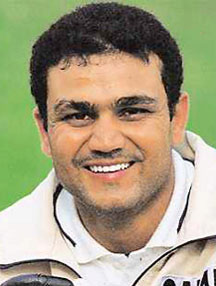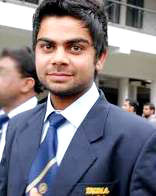IT was eventually derided for its seemingly infinite duration, its overbearing security, its high ticket prices and much more besides but at least the 2007 World Cup in the Caribbean packed more shocks and drama into its first week than a Hollywood blockbuster.
In contrast, the 2011 version has started with the predictability of a tedious documentary.

Nearly three weeks and 32 matches remain before the knockout stages of quarter and semi-finals, leading to the final in Mumbai on April 2. So there is ample time for the excitement to build but, except for yesterday’s close sub-continental clash between Sri Lanka and Pakistan, in front of 31,000 at the Premadasa Stadium in Colombo, there hasn’t yet been much to capture the imagination.
After India’s second match, against England in Bangalore today, more dull matches involving two International Cricket Council (ICC) associates, Canada, Ireland, Kenya and the Netherlands, and the rebuilding Zimbabwe, lie ahead during the week.
Not so four years ago.
By this time, Ireland and Zimbabwe had battled to the World Cup’s third tie at Sabina Park. Two days later, on St. Patrick’s Day, the Irish were again involved in the unexpected toppling of Pakistan, also at Sabina, while Bangladesh were defeating India at the Queen’s Park Oval, ousting two of the more fancied teams at the first stage.

The next morning, there was a blow of a different kind as news of the overnight death of Pakistan coach, the former England player Bob Woolmer, stunned the world and placed the event itself in doubt. Not until yesterday did any result reverse the present ICC rankings, Pakistan (No.6) overcoming Sri Lanka (No.3).
Even so, Pakistan have always been the game’s most dangerous opponents and no one doubts that, wherever they are officially placed, they are capable of repeating their 1992 triumph under Imran Khan.
The previous nine matches simply confirmed expectations that the eight quarter-finalists will come from among ICC’s nine Test-playing members.
Australia, New Zealand and Pakistan are as certain as certain can be from Group A that is rounded out by Canada and Kenya, the two weakest associates, who were embarrassingly thrashed in their opening matches, and No.10 ranked Zimbabwe.
The odd one out will almost certainly come from the five full member teams in Group B (Bangladesh, England, India, South Africa and the West Indies) where a slip-up against Ireland and the Netherlands, the most capable associates, could prove decisive.
The West Indies are next up, tomorrow in Delhi against the Netherlands who gave England a genuine fright in their opener last Tuesday. On the immediate evidence, the strongest contenders are Australia, India and South Africa.
Mercurial Pakistan, for all the recent turmoil of guilty verdicts against three of their best players for spot-fixing and the security problems that have prevented their country taking up its delegated role as co-hosts for the Cup, also staked their claim last night.
But they won’t go all the way with the slapdash fielding and keeping that marked their cricket.
The loss would have damaged Sri Lanka’s confidence at a venue generally considered their fortress. Yet they remain a well-balanced, well led combination resilient enough to overcome such a setback.

For all their thrashing by England in the recent Ashes Test series, Australia are still No.1 on the ODI rankings and with the incentive of claiming their fourth consecutive Cup title.
India (No.2) are strong in batting and have the considerable benefit of home advantage. South Africa (No.4) for once are as well balanced as any and confident they can finally shake the taunt of ‘chokers’ that understandably infuriates them.
India set their standards in the opening match. They crossed the border to confront Bangladesh, a potentially difficult challenge, amassed 370 for four when sent in, with hundreds by Virender Sewag (175) and young Virat Kohli (100 not out) underscoring victory by 87 runs.
Sachin Tendulkar was run out for 28, Gautam Gambhir contributed 38 and MS Dhoni didn’t even get in. They will not be easily beaten.
Australia are bucking the trend of other teams which have concentrated their bowling on spin in recognition of the traditionally slow, turning wickets.
They have invested in the raw speed of Shaun Tait and the control of his pace colleagues, Brett Lee and Mitchell Johnson, and they swept aside Zimbabwe and New Zealand in their two opening victories. It is a tactic that will be tested by Sri Lanka and Pakistan in the group but they won’t change it as it is their power.
South Africa, traditionally deficient in spin, have entered the tournament more reliant on it than ever.
Johan Botha’s off-spin was employed for the new ball against the West Indies on Thursday and left-arm spinner Robin Peterson was in the eleven. But the addition of the leg-spin of the Pakistan-born migrant, Imran Tahir, is the most important addition to their formidable pace-based attack spearheaded by Dale Steyn and Morne Morkel.
It earned him four wickets on debut against the West Indies and, if he will be more meaningfully tested by batting sides more proficient against his type, he should enjoy the kind of pitches on which he learned his art while growing up in Lahore.
If their lower order batting appears suspect they are unlikely to be concerned with Hashim Amla, captain Graeme Smith, Jacques Kallis and AB deVilliers at the top.
The majority forecast before Sewag punched the first ball of the tournament to the point boundary eight days ago was for India to be in the final come April 2. It was more than national sentimentality and a bet to that effect with any bookmaker, legal or otherwise, won’t earn a fortune.
To predict the other finalist and the eventual champions could.
With the realisation that the West Indies are not strong or confident enough to reach nearly that far and on the immediate form, my money, if I had any, would be on a India-South Africa final – but there is still a long wait until it can happen.



